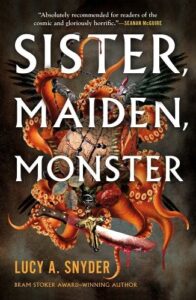Description is critical in good, immersive fiction. It first and foremost enables the reader to richly imagine the world that a writer has created. But good description does more than provide the sensory and physical details crucial in setting, characterization, action, and world building. The ways in which characters see and describe their worlds deepen personality, establish point of view, convey motivation, ratchet up tension, and move the plot along. Ultimately, the description is the thread that connects the who, what, when, where, and why in any narrative.
Creating mood and atmosphere centers on the manner in which something is described.
The sound of words matter: hard vowels and sibilants can imply a sense of threat. Soft vowels create a more muted feeling. For others, it depends on context. “Oo” sounds can be soothing, or a little spooky, depending on context.
Using menacing or grotesque imagery to describe ordinarily innocuous objects can increase the tension and sense of threat: referring to a dark hallway as a “hungry throat”, for instance, or using imagery involving knives or teeth for other objects.
The Meresee was a narrow blade of lake hemmed in tight by the Bavarian Alps. Their peaks tore into the summer sky like teeth on a ragged jaw, doubled in the mirror surface of the lake below. It was just the sort of alpine vista that sent English tourists skittering across the Alps with their easels and folding chairs, pencils and watercolors.
— from “A Human Stain” by Kelly Robson
Using grotesque or threatening imagery to undercut pleasant sensory images can increase the sense of unease or horror in a scene. Done deliberately and appropriately, this works well; inappropriately it can destroy the effect of a passage if you don’t intend to disturb the reader.
A feathery shift of air drifted from below, ruffling her hair. It smelled delicious, sea-salty and savory, like a good piece of veal charred quickly over white-hot coals and sliced with a sharp knife into bleeding red pieces.
— from “A Human Stain” by Kelly Robson
Going overboard with this (or any other kind of description) can result in purple prose, which can be unintentionally funny. Or, simply impossible to wade through.
Grignr’s emerald green orbs glared lustfully at the wallowing soldier struggling before his chestnut swirled mount. His scowling voice reverberated over the dying form in a tone of mocking mirth. “You city bred dogs should learn not to antagonize your better.” Reining his weary mount ahead, grignr resumed his journey to the Noregolian city of Gorzam, hoping to discover wine, women, and adventure to boil the wild blood coarsing through his savage veins.
— from The Eye of Argon by Jim Theis
Creating a deliberately amusing description via exaggeration can pair well with a threatening one, particularly if you’re writing horror comedy or action comedy.
There exists in this world a spider the size of a dinner plate, a foot wide if you include the legs. It’s called the Goliath Bird-Eating Spider, or the “Goliath Fucking Bird-Eating Spider” by those who have actually seen one. …
I don’t know how they catch the birds. I know the Goliath Fucking Bird-Eating Spider can’t fly because if it could, it would have a different name entirely. We would call it “sir” because it would be the dominant species on the planet. None of us would leave the house unless a Goliath Fucking Flying Bird-Eating Spider said it was okay.
— from This Book Is Full of Spiders: Seriously, Dude, Don’t Touch It by David Wong
Conversely, describing threatening things in a casual way can convey the sense that the point-of-view (POV) character has things well under control. The risk? Such casual description will often de-escalate the sense of threat and tension in a scene unless you’re conveying that the POV character is still invested in what’s happening. If the character seems bored and disengaged, there’s the risk the reader will be bored and disengaged, too. So be cautious about too many flippant descriptions because they can cause readers to check out of the narrative.
Guidelines for Descriptive Passages
Good Description:
- Establishes the setting and builds the physical details of “who, what, where, and how” of the narrative
- Enables the reader to visualize where the narrative takes place
- Conveys an appropriate sense of place
- Is selective, specific, sensory, and vivid
- Engages all the senses, not just sight and hearing!
- An “eyeball kick”: a vivid, telling detail that creates rich, interesting visual imagery with just a few words.
- Use specific words. Use words that make sense for the POV character.
- Is conveyed through the POV character’s personal perspective
- Focuses on details that matter to the POV character
- What would this character be impressed by, afraid of, frustrated with, or excited about?
- Takes into account things like:
- Personal history
- Profession
- Education
- Social class, culture, etc.
- Conveys character opinions, emotions and inner thoughts
- Connects to the character’s memories
- Builds the character and his/her social/political/cultural sphere
- Focuses on details that matter to the POV character
- Moves the plot and builds narrative tension
- Sets the mood, enhances style, builds theme
- Conveys action and character blocking in scenes
- Understand what’s happening in the scene yourself! It’s difficult to create clear descriptions of things and actions that you only imagine vaguely.
- Exhaustive, blow-by-blow descriptions of actions are often boring
- Battles are often confusing; strive for clarity
- Be specific about what’s happening
- Providing a few selective, vivid, visceral details is often enough to help the reader visualize the scene.
- Shorter, punchier sentences often work best
- Stream-of-consciousness run-on sentences can work, depending
- Avoid passive voice/sentence construction that sap urgency
- Convey character emotions and match an emotional arc to the physical one
- Does the action scene reveal something about the character(s)?
- Make sure the physics of what’s happening rings true for the reader!
- Confusing or unbelievable actions will kick the reader out of the narrative
- Make sure that violence has believable consequences
- If you’re uncertain, take a fight class, or watch videos of fights.
Note: some perfectly acceptable descriptions use only a few of the elements above, but they employ them to excellent effect.
Always, always, always remember:
- Good description focuses on details that matter to the POV character
- Make sure that you have chosen a POV character who is engaged with their world in a meaningful way so that you can describe the relevant details through their senses and perspective.
- Convey what this character is impressed by, afraid of, frustrated with, or excited about!
***


















